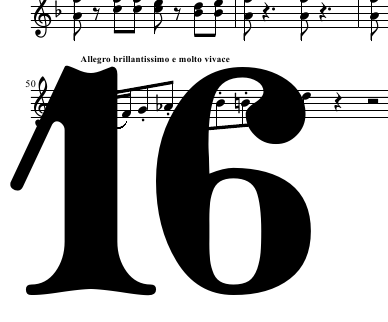

- #Multi measure rest musescore update
- #Multi measure rest musescore manual
- #Multi measure rest musescore software

#Multi measure rest musescore manual
The algorithm is designed to produce good results in most cases with no manual intervention required, while still offering full manual control when you need it.Īs an example, here is a score entered into MuseScore 2, showing the sort of collisions that users have previously had to resolve manually. The automatic placement facility in MuseScore aims to strike a balance between simplicity and flexibility. So let’s see what’s new and improved in MuseScore 3. MuseScore 3 remains free and open source, and you can download it from MuseScore’s web site for Windows, macOS, and Linux.Ī number of the new features will be familiar to users of existing commercial software, although it’s worth noting the particular ways that MuseScore implements features and integrates them into the software.

The intention is to move to a more app-like model of having frequent updates – perhaps monthly – as opposed to having releases only every year or so.
#Multi measure rest musescore update
To help users keep their version of MuseScore current, MuseScore 3 now supports an automatic update system.
_LI.jpg)
MuseScore 3 is improved in many other ways as well, including an increased focus on usability with new popup Tours to guide first time users, new “timewise” methods for inserting and deleting notes within measures, new Timeline and Score Comparison windows, redesigned and improved Mixer and Piano Roll Editor windows, searchable palettes, new notation features such as automatic system dividers, temporary and cutaway staves, the ability to generate parts from multiple voices on a single staff, named noteheads, an expanded MuseJazz font to give your music a handwritten appearance, and more. The result is that it is now easier and faster than ever to create scores that look good. In addition, more powerful Style and Inspector windows give you more control over the default position, appearance, and behavior of elements. Autoplace detects and resolves potential collisions between score elements by automatically adjusting the position and spacing of text, symbols, and staves, while still allowing users full manual control. The most notable improvement in MuseScore 3 is the new automatic placement (a.k.a. There was a “soft launch” of MuseScore 3 during the 2018 Christmas holiday season MuseScore 3.0.1 fixes dozens of issues that were found in the original 3.0 release and adds a few improvements. Yesterday MuseScore released MuseScore 3.0.1.
#Multi measure rest musescore software
It’s the first major new version of the software since MuseScore 2 was released in 2015, and the first since MuseScore was acquired by Ultimate Guitar nearly a year ago in February 2018.


 0 kommentar(er)
0 kommentar(er)
